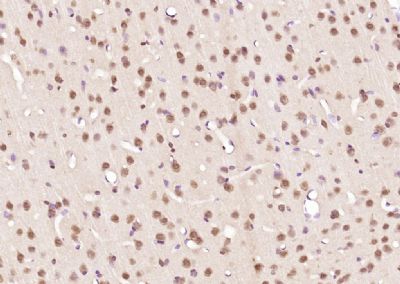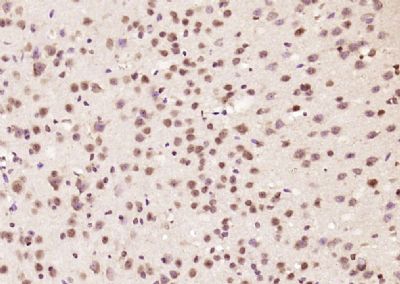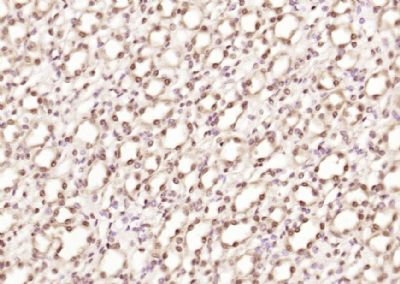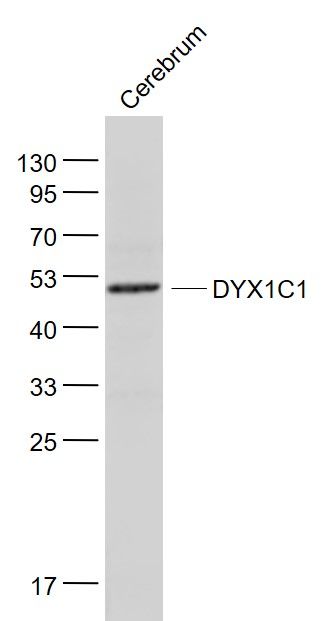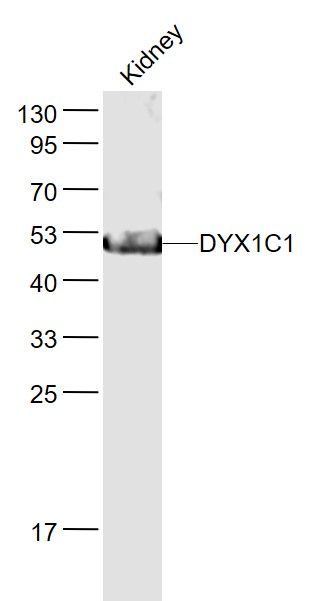DYX1C1 Polyclonal Antibody
Purified Rabbit Polyclonal Antibody (Pab)
- SPECIFICATION
- CITATIONS
- PROTOCOLS
- BACKGROUND

Application
| WB, IHC-P, IHC-F, IF, ICC, E |
|---|---|
| Primary Accession | Q8WXU2 |
| Reactivity | Rat, Dog, Bovine |
| Host | Rabbit |
| Clonality | Polyclonal |
| Calculated MW | 49 KDa |
| Physical State | Liquid |
| Immunogen | KLH conjugated synthetic peptide derived from human DYX1C1 |
| Epitope Specificity | 51-120/420 |
| Isotype | IgG |
| Purity | affinity purified by Protein A |
| Buffer | 0.01M TBS (pH7.4) with 1% BSA, 0.02% Proclin300 and 50% Glycerol. |
| SUBCELLULAR LOCATION | Nucleus. Cytoplasm. |
| SIMILARITY | Contains 1 CS domain. Contains 3 TPR repeats. |
| SUBUNIT | Interacts with ESR1 and ESR2. Interacts with STUB1. |
| DISEASE | Defects in DYX1C1 may be a cause of susceptibility to dyslexia type 1 (DYX1) [MIM:127700]. A relatively common, complex cognitive disorder characterized by an impairment of reading performance despite adequate motivational, educational and intellectual opportunities. It is a multifactorial trait, with evidence for familial clustering and heritability. Note=A chromosomal aberration involving DYX1C1 has been found in a family affected by dyslexia. Translocation t(2;15)(q11;q21). |
| Important Note | This product as supplied is intended for research use only, not for use in human, therapeutic or diagnostic applications. |
| Background Descriptions | The gene encoding DYX1C1 maps in the 15q21 region, which is disrupted by a translocation t(2;15)(q11;q21) and segregates with dyslexia. Two sequence changes in DYX1C1, including one involving the translation initiation sequence and an Elk-1 transcription factor binding site (-3G --> A) and a codon (1249G --> T), introduce a premature stop codon and truncate the protein by 4 amino acids. DYX1C1 encodes a nuclear tetratricopeptide repeat domain protein that is dynamically regulated in brain. In human brain, DYX1C1 protein localizes to a fraction of cortical neurons and white matter glial cells. It is also expressed in lung, kidney and testis. |
| Gene ID | 161582 |
|---|---|
| Other Names | Dynein assembly factor 4, axonemal {ECO:0000312|HGNC:HGNC:21493}, Dyslexia susceptibility 1 candidate gene 1 protein, DNAAF4 (HGNC:21493), DYX1C1, EKN1 |
| Target/Specificity | Expressed in several tissues, including brain, lung, kidney and testis. In brain localizes to a fraction of cortical neurons and white matter glial cells. |
| Dilution | WB=1:500-2000,IHC-P=1:100-500,IHC-F=1:100-500,ICC=1:100-500,IF=1:100-500,ELISA=1:5000-10000 |
| Format | 0.01M TBS(pH7.4), 0.09% (W/V) sodium azide and 50% Glyce |
| Storage | Store at -20 ℃ for one year. Avoid repeated freeze/thaw cycles. When reconstituted in sterile pH 7.4 0.01M PBS or diluent of antibody the antibody is stable for at least two weeks at 2-4 ℃. |
| Name | DNAAF4 (HGNC:21493) |
|---|---|
| Synonyms | DYX1C1, EKN1 |
| Function | Axonemal dynein assembly factor required for ciliary motility. Involved in neuronal migration during development of the cerebral neocortex. May regulate the stability and proteasomal degradation of the estrogen receptors that play an important role in neuronal differentiation, survival and plasticity. |
| Cellular Location | Nucleus. Cytoplasm. Dynein axonemal particle. Cell projection, neuron projection {ECO:0000250|UniProtKB:Q5VJS5} |
| Tissue Location | Expressed in several tissues, including brain, lung, kidney and testis. In brain localizes to a fraction of cortical neurons and white matter glial cells. |

Thousands of laboratories across the world have published research that depended on the performance of antibodies from Abcepta to advance their research. Check out links to articles that cite our products in major peer-reviewed journals, organized by research category.
info@abcepta.com, and receive a free "I Love Antibodies" mug.
Provided below are standard protocols that you may find useful for product applications.
If you have used an Abcepta product and would like to share how it has performed, please click on the "Submit Review" button and provide the requested information. Our staff will examine and post your review and contact you if needed.
If you have any additional inquiries please email technical services at tech@abcepta.com.













 Foundational characteristics of cancer include proliferation, angiogenesis, migration, evasion of apoptosis, and cellular immortality. Find key markers for these cellular processes and antibodies to detect them.
Foundational characteristics of cancer include proliferation, angiogenesis, migration, evasion of apoptosis, and cellular immortality. Find key markers for these cellular processes and antibodies to detect them. The SUMOplot™ Analysis Program predicts and scores sumoylation sites in your protein. SUMOylation is a post-translational modification involved in various cellular processes, such as nuclear-cytosolic transport, transcriptional regulation, apoptosis, protein stability, response to stress, and progression through the cell cycle.
The SUMOplot™ Analysis Program predicts and scores sumoylation sites in your protein. SUMOylation is a post-translational modification involved in various cellular processes, such as nuclear-cytosolic transport, transcriptional regulation, apoptosis, protein stability, response to stress, and progression through the cell cycle. The Autophagy Receptor Motif Plotter predicts and scores autophagy receptor binding sites in your protein. Identifying proteins connected to this pathway is critical to understanding the role of autophagy in physiological as well as pathological processes such as development, differentiation, neurodegenerative diseases, stress, infection, and cancer.
The Autophagy Receptor Motif Plotter predicts and scores autophagy receptor binding sites in your protein. Identifying proteins connected to this pathway is critical to understanding the role of autophagy in physiological as well as pathological processes such as development, differentiation, neurodegenerative diseases, stress, infection, and cancer.
